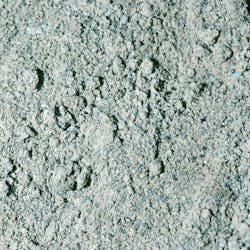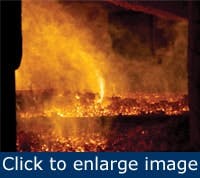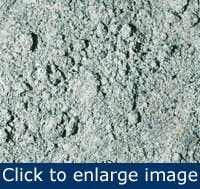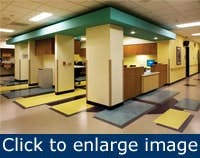Using ash in concrete is nothing new. The Romans used volcanic ash in their spectacular construction projects long before the introduction of Portland cement, having discovered its value as a hardening agent when mixed with lime. The ancient Romans used volcanic ash as an admix to erect buildings such as the Pantheon and Coliseum, roads, and aqueducts. Remember, these structures are more than 2,000 years old.
Fly ash concrete was first used in the U.S. in the 1920s for dam construction, when engineers found that it reduced the total cement requirement. Today, as more projects seek LEED certification, ash is resurfacing as a popular environmentally-friendly alternative to Portland cement. No longer are we using volcanic ash, of course, but coal fly ash is gaining ground as the green alternative of choice for LEED projects. Many of the projects and the millions of square yards of LEED flooring we’ve installed in recent years used ash in the cement mixture. While fly ash holds benefit as a recycled component, it also presents flooring contractors with unique challenges.
What is fly ash?
To understand the green benefit and challenges that fly ash brings to the flooring process, you must understand fly ash. It’s a byproduct of coal power plants, which account for more than half of the electricity we consume in the United States, according to Headwaters Resources in South Jordan, Utah, which supplies materials derived from coal combustion products, including fly ash, nationwide.
“Fly ash is composed of the non-combustible mineral portion of coal. When coal is consumed in a power plant, it’s first ground to the fineness of powder. Blown into the power plant’s boiler, the carbon is consumed — leaving molten particles rich in silica, alumina and calcium. These particles solidify as microscopic, glassy spheres that are collected from the power plant’s exhaust before they can “fly” away — hence the product’s name: fly ash,” according to a Headwaters report.
Fly ash is considered the modern-day “Pozzolan,” a word that comes from the Italian city, Pozzuoli, which most consider the birthplace of ash concrete technology. Pozzolan is a siliceous material that by itself possesses no cementitious value. However, with the presence of moisture, it reacts with calcium hydroxide to form a compound with cementitious properties.
Concrete made with fly ash is strong, durable and resistant to chemical attack, as evidenced by the many early Roman buildings still standing.
Why fly ash is popular
Traditionally-produced Portland cement, while extremely versatile and strong, is not environmentally friendly. According to the Green Resource Center, the manufacture of Portland cement accounts for 6% to 7% of the total carbon dioxide (CO2) humans produce. That equates to the greenhouse-gas equivalent of 330 million cars, each driving 12,500 miles per year.
Coal fly ash is a coal-fired power plant waste byproduct, which otherwise would end up in a landfill. Its use in cement reduces the energy demands of manufacturing other concrete ingredients, reducing energy consumption, costs and greenhouse emissions, and slowing the depletion of natural resources. In fact, according to Headwaters research, more than 12 million tons of coal fly ash are used in American concrete products each year.
Because of coal fly ash’s green qualities, its use in concrete can generate points toward LEED certification by the U.S. Green Building Council:
- Materials & Resources
- MR Credit 4.1 Recycled Content
- MR Credit 4.2 Recycled Content
Effect on flooring installation
In the past several years, we’ve gained extensive experience in commercial LEED projects, many of which used fly ash in the concrete. We found that, while fly ash benefits concrete durability and strength, makes it more workable, and is the green thing to do, its use as an additive in concrete can generate some fairly challenging bonding issues with flooring. Here’s why:
Fly ash is one of the residues generated in coal combustion. Depending on the source and type of coal being burned, fly ash makeup varies considerably, but all fly ash contains substantial amounts of silicon dioxide and calcium oxide.
If you’ve ever tried to attach anything to a silicon-based product, you know firsthand that it won’t stick. Similarly, calcium oxide, also known as quicklime or burnt lime, is a caustic, alkaline crystalline byproduct — and like other high-alkalinity products, plays havoc with flooring adhesives. “The fly in the ointment, or in this matter, the fly ash, is that nothing will stick to this type of concrete regardless of what you do,” wrote Lew Migliore, president and owner of The Commercial Flooring Report in March 2008. He advised flooring contractors to get involved early in the specification process to prevent specifying or trying to install products that simply won’t stick.
The American Coal Ash Association and the flooring industry have been working to address this problem since 2008. In response to issues raised in that 2008 article, ACAA Executive Director David Goss said, “There have been many successful projects in which coal fly ash (CFA) has replaced more than the typical 20% to 30% replacement levels. However, as the replacement levels are increased, a change in the typical concrete placement and curing process should be observed. In other words, more can be better, provided the unique characteristics of fly ash are accounted for during the engineering phase of the program.
“To this end,” he continued, “it has been noted while the bonding characteristics of certain flooring compounds are acceptable in applications where typical CFA replacement levels are used, very little is known about these characteristics when higher levels of CFA are utilized. The historical mechanisms of concrete failure (pH, moisture and type of finish) need to be evaluated as a function of CFA loading to determine if the loading levels are relevant. We believe that sound research evaluating various mix designs under simulated operating conditions will help identify any precautions or finishing processes that will enable your industry to provide high quality flooring for any application.”
While the ACAA and flooring industry collaborate to research the optimum fly ash concentration levels, flooring installers are left to face the challenges.
On the ground: Dell Children’s
The Dell Children’s Medical Center in Austin is a great example of the value, and challenges, encountered with fly ash in concrete. Built in 2007, Dell Children’s was the first Platinum LEED hospital in the world. To achieve the highest LEED designation demanded that the project incorporate every possible opportunity to gain LEED points. This 500,000-sq.ft.project had about 40,000 sq.yds. of linoleum and 175,000 ft. of hand-cut seams just for inset patterns. One of the project team’s goals was to reduce cement use, carbon dioxide and greenhouse effects. So, the team substituted fly ash for a portion of the cement, pouring 41,000 cu.yd. of the fly-ash concrete in the foundation and walls.
According to Roger Vokt, superintendent of Greater Austin Development, which poured the concrete on this project, the pilings for Dell Children’s job had as much as 50% fly ash content. The slab on which we installed flooring contained between 30% and 35% fly ash.
[pullquote]A white paper published a few years after we completed the project documented that high concentrations of fly ash in concrete used in new LEED projects across the country was failing. But, at the time of the Dell Children’s construction, we were learning on the fly, so to speak. Very quickly into the installation project our teams began experiencing significant challenges attaching the linoleum to the slab, even though all normal readings (moisture and alkaline) were within the manufacturer’s recommended tolerances.
We stopped the job for about 30 days, attempting to resolve the issue. During this time, we did an enormous amount of testing and explored a variety of methods we thought might cure the problem. We even called on concrete experts to core the slab to determine the cause of this non-adhesion. We couldn’t determine the cause, but did come up with a solution. We found that a very aggressive scarifying of the surface of the concrete (just less than bead blasting), was the best way to get the linoleum to stick. The additional floor preparation ultimately enabled us to install the flooring successfully, but at significant additional cost to us.
We also performed mechanical bond testing throughout the project to verify that our solution was working. This is a tried-but-true test that tells the story as far as material being bonded to the subfloor. We conducted this test in addition to the moisture and alkalinity testing that we perform on each of our projects.
Lessons learned
Since the Dell project, we now routinely encounter fly ash in cement in LEED projects — and in fact, we approach the bid process for those jobs expecting that we will be dealing with high concentrations of fly ash. We now know that the maximum level that avoids complications in adhering floor covering is 15% fly ash. We know that projects with concentrations in the 30% to 35% range should expect and plan for significant additional costs in prepping the floor to install materials. Having encountered this situation routinely now on LEED installations, we know what to look for and adjust, including changes to the flooring adhesive itself, if necessary.
As Migliore advised in 2008, savvy flooring contractors should ask the general or concrete contractor about the concrete composition at the outset of the project. If your project contains fly ash, make sure you have an experienced flooring contractor who knows how to respond:
- Shot blast the floor to open it up to allow sealants to adhere
- Use a cementitious or polymeric sealer
- Specify products with the most likelihood of adhering.
While stretch-in carpet, laminated flooring and free-floating floors might be the best flooring options in these cases, those solutions might not be practical for commercial surfaces. The fact is that almost any flooring surface might be used, but additional preparation might be required and probably will represent an additional expense to the owner.
Like the saying, “buyer beware.” When it comes to LEED projects, architects, contractors and owners should ensure they choose a flooring contractor that keeps up with the latest technology and that can troubleshoot problems to find a solution — or better yet, circumvent problems before they occur. Be sure to choose a flooring partner that is aware of fly ash and its challenges, and one that will be vigilant and cautious early on in researching the concrete on which it will be expected to install product.
In anticipation of those situations, expect to see exclusion clauses in your flooring contractor’s proposal and contract. We now include a clause in our proposals that, along with moisture and alkalinity issues typically associated with concrete slabs, excludes “floor preparation required to adhere floor coverings if a high concentration of fly ash or other additives that impede the adhesion of flooring materials” is present on these projects.
No doubt, fly ash will continue to grow in popularity as LEED projects become the norm in commercial construction. By doing your research early in the project, being aware of the effect of fly ash on flooring installation and planning for extra floor prep, and choosing an experienced LEED flooring expert, you can meet these green demands without ruining your project’s bottom line.
Bill Imhoff is CEO of Intertech Flooring, Austin, Texas. Contact him at [email protected] and (512) 385-4574.



